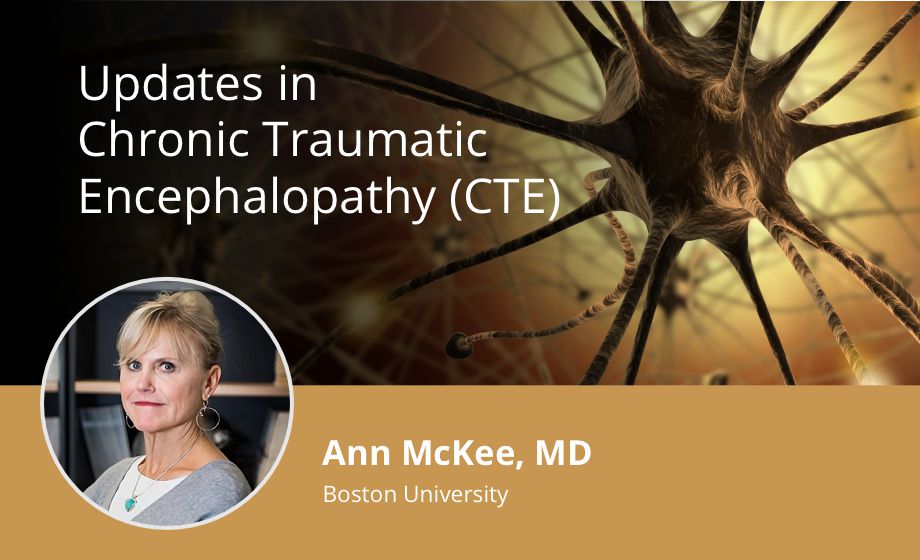How High-Impact Sports Affect Brain Health: Chronic Traumatic Encephalopathy (CTE)
Blog post by Abigail Johnson
Chronic Traumatic Encephalopathy (CTE) is a condition that arises from a long history of repeated head traumas. Those who experience these types of traumas, such as in high-impact sports or intense warfare, are more at risk to develop CTE. The symptoms often vary by individual, but typically include cognitive and behavioral impairments, as well as Parkinsonian motor impairments (1). Over time, the brain itself begins to deteriorate, developing a buildup of tau proteins that is similar yet distinct from the tau bodies seen in Alzheimer’s disease (2). Since this conditions discovery no cure has been developed, and unfortunately CTE can only be diagnosed after death; however symptoms are often apparent to friends and family long before that.
Dr. Ann McKee describes the emergence of chronic traumatic encephalopathy (CTE) as a distinct disease over the past 20 years. Learn more about Dr. McKee’s research in this webinar that you can WATCH HERE.
The History of CTE
CTE was first identified in National Football League (NFL) Hall of Famer Mike Webster. Webster, nicknamed “Iron Mike”, played for the Pittsburgh Steelers for fifteen years and the Kansas City Chiefs for two years. At the center position, he often took on the opponents’ biggest players, resulting in the hardest hits. Webster had a reputation for using his head as a battering ram and estimated that he had taken around twenty-five thousand significant hits to his head throughout his career. After he retired from football, his cognitive abilities declined severely, and his behavior became erratic and uncontrollable (3).
Mortician Bennet Omalu analyzed Mike Webster’s brain after his death and found dead brain tissue and tau protein build-up (4), which led to the discovery of CTE as a new and unique condition. Since then, there has been a great deal of research into CTE among professional football players, boxers and military veterans — those that are the highest risk population for this acute neurodegenerative disorder.
New Developments in CTE Research
One of the difficulties in treating CTE is that it cannot be diagnosed while the patient is still alive; but this may change in the near future. Researchers at Boston University are looking into the possibility of using MRI to diagnose CTE. MRI is often used to diagnose other neurodegenerative disorders, such as Alzheimer’s disease, so there is a good possibility that this imaging technique could prove successful in identifying CTE before death (5).
Researchers’ next steps are to look at the white matter profiles of CTE brains, in addition to gray matter. White matter in the brain is made up of axonal tracks and non-neuronal cells, and these regions are incredibly important for transmitting brain signals and maintaining brain health and homeostasis. In many cases of CTE, white matter regions are significantly decreased, and there is altered functioning in non-neuronal cell types, which could be contributing to disease severity (6,7).
How to Prevent CTE
CTE is still a relatively rare disease among the general population, although among professional football players and other high-risk populations it is much more common. Clearly, taking steps to decrease head injury can help decrease risk of CTE. For children involved in contact sports, there are a few key steps to help reduce risk of repeated head injury:
Use proper head protection.
Safety gear can make a substantial difference in the severity of both minor and major hits. Helmets and other gear can reduce the force of impact on the head and decrease the brain-skull collision, which helps protect against concussion or injury. Helmets will not prevent head injury, but they can help to reduce it (8)
If injured, report it.
If an athlete takes a big hit to the head during a game or practice, the worst thing to do is to continue playing. This puts the athlete at more risk for making the head trauma worse or receiving another head trauma. After a significant hit, it is important to assess the damage and determine whether it is safe to continue, or if concussion testing is necessary.
Follow concussion protocols.
New protocols following concussion have been developed to ensure that the brain is fully healed before it is put at risk of being reinjured. By following these protocols, athletes can significantly reduce risk of a second concussion.
Raise awareness for CTE.
Many athletes still don’t know or understand the risks involved every time they get out onto the field. By increasing awareness of CTE and the damage that can result from head injuries, players can make informed decisions on their brain health.
About the Author
About the Author

Abigail Johnson is one of the recipients of the Scientist.com STEM Research NIL Award. Abigail is a senior studying Biology and Neuroscience at Syracuse University, who has been researching the effects of in utero vitamin D supplementation on early symptomatic mouse models of Rett syndrome (RTT).
References
- Mayo Clinic. Chronic traumatic encephalopathy (CTE) – Symptoms and causes [Internet]. [Accessed 2023 May 12]. Available from: https://www.mayoclinic.org/diseases-conditions/chronic-traumatic-encephalopathy/symptoms-causes/syc-20370921#:~:text=Chronic%20traumatic%20encephalopathy%20(CTE)%20is,is%20not%20yet%20well%20understood.
- Alzheimer’s Association. Chronic Traumatic Encephalopathy [Internet]. [Accessed 2023 May 12]. Available from: https://www.alz.org/alzheimers-dementia/what-is-dementia/related_conditions/chronic-traumatic-encephalopathy
- Fainaru-Wada M, Fainaru S. League of Denial: The NFL, Concussions, and the Battle for Truth. Three Rivers Press; 2014.
- Omalu BI, DeKosky ST, Minster RL, Kamboh MI, Hamilton RL, and Wecht, Cyril H. Chronic Traumatic Encephalopathy in a National Football League Player. Neurosurgery. 2005;57:128-34. doi: 10.1227/01.NEU.0000163407.92769.ED
- Alosco ML, Mian AZ, Buch K. et al. Structural MRI profiles and tau correlates of atrophy in autopsy-confirmed CTE. Alz Res Therapy. 2021;13,:193. doi: 10.1186/s13195-021-00928-y
- Chancellor KB, Chancellor SE, Duke-Cohan, JE et al. Altered oligodendroglia and astroglia in chronic traumatic encephalopathy. Acta Neuropathol. 2021;142:295–321. doi: 10.1007/s00401-021-02322-2
- Alosco ML, Stein TD, Tripodis Y, et al. Association of White Matter Rarefaction, Arteriolosclerosis, and Tau With Dementia in Chronic Traumatic Encephalopathy. JAMA Neurol. 2019;76(11):1298–1308. doi: 10.1001/jamaneurol.2019.2244
- Daneshvar DH, Baugh CM, Nowinski CJ, McKee AC, Stern RA, Cantu RC. Helmets and mouth guards: the role of personal equipment in preventing sport-related concussions. Clin Sports Med. 2011;30(1):145-63. doi: 10.1016/j.csm.2010.09.006
